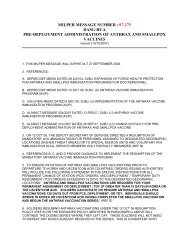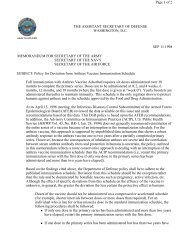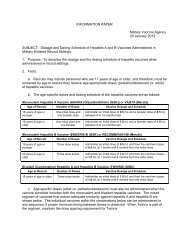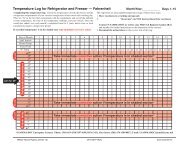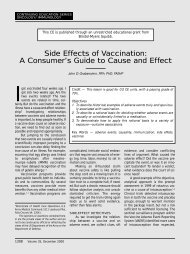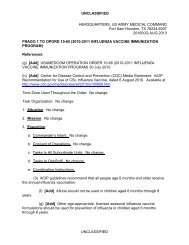Botulism Vaccination Program Question and Answers ... - MILVAX
Botulism Vaccination Program Question and Answers ... - MILVAX
Botulism Vaccination Program Question and Answers ... - MILVAX
You also want an ePaper? Increase the reach of your titles
YUMPU automatically turns print PDFs into web optimized ePapers that Google loves.
<strong>Botulism</strong> <strong>Vaccination</strong> <strong>Program</strong><br />
<strong>Question</strong>s <strong>and</strong> <strong>Answers</strong><br />
Prepared by<br />
Military Vaccine Agency - Vaccine Healthcare Centers Network (<strong>MILVAX</strong>-VHCN),<br />
Office of The Army Surgeon General, U.S. Army<br />
Last Updated: 19 Dec 05<br />
www.vaccines.mil<br />
877-GET-VACC<br />
DoDVaccines@mail.mil
<strong>Botulism</strong> <strong>Vaccination</strong> <strong>Program</strong><br />
<strong>Question</strong>s <strong>and</strong> <strong>Answers</strong><br />
The Disease<br />
A. Overview<br />
B. Symptoms<br />
C. Complications<br />
Adapted from the Immunization Action Coalition (with permission) <strong>and</strong> the Centers for Disease Control <strong>and</strong> Prevention (CDC).<br />
www.vaccines.mil - Page 2 of 5 - 19 Dec 05
The Disease<br />
A.<br />
Overview<br />
1.<br />
2.<br />
3.<br />
What is botulism<br />
<strong>Botulism</strong> is a rare but serious illness involving paralysis of the muscles. <strong>Botulism</strong> is caused<br />
by a toxin produced by bacteria called Clostridium botulinum.<br />
What is Clostridium botulinum<br />
Clostridium botulinum is the name of a group of bacteria commonly found in soil. These<br />
organisms grow best in low oxygen conditions. The bacteria form spores that allow them to<br />
survive in a dormant (inactive) state until exposed to conditions that support their growth.<br />
There are seven types of botulism toxin, designated by the letters A through G. Only types<br />
A, B, E <strong>and</strong> F routinely cause illness in humans.<br />
How do people get botulism<br />
There are three main kinds of botulism: Foodborne botulism, wound botulism, <strong>and</strong> infant<br />
botulism.. Foodborne botulism occurs after eating food contaminated with botulism toxin.<br />
<strong>Botulism</strong> is a concern with home-canned foods. The reason for the careful boiling <strong>and</strong> other<br />
precautions during canning is to avoid botulism.<br />
Wound botulism is caused by toxin produced within a wound infected with Clostridium<br />
botulinum bacteria. For example, if soil containing botulism spores fell into an open wound,<br />
the spores could turn back into bacteria <strong>and</strong> produce toxins.<br />
Infant botulism is caused by consuming the spores of botulism bacteria, which then grow in<br />
the intestines <strong>and</strong> release toxin. The reason you shouldn’t feed honey to an infant is<br />
because of the risk the honey might contain botulism spores.<br />
All three forms of botulism can be life-threatening <strong>and</strong> should be treated as medical<br />
emergencies. Foodborne botulism is especially dangerous, because many people can be<br />
poisoned by eating from the same contaminated food source.<br />
4.<br />
Can botulism be prevented<br />
<strong>Botulism</strong> can be prevented. Food-borne botulism often occurs from home-canned foods with<br />
low acid content, such as asparagus, green beans, beets <strong>and</strong> corn. However, outbreaks of<br />
botulism from more unusual sources such as chopped garlic in oil, chili peppers, tomatoes,<br />
improperly h<strong>and</strong>led baked potatoes wrapped in aluminum foil, <strong>and</strong> home-canned or<br />
fermented fish.<br />
People who do home canning should follow strict hygienic procedures to reduce<br />
contamination of foods. Oils infused with garlic or herbs should be refrigerated. Potatoes<br />
that have been baked while wrapped in aluminum foil should be kept hot until served or<br />
refrigerated. Because the botulism toxin is destroyed by high temperatures, people who eat<br />
home-canned food should consider boiling the food for 10 minutes before eating it to ensure<br />
safety. Instructions on safe home canning can be obtained from county extension services<br />
www.vaccines.mil - Page 3 of 5 - 19 Dec 05
or from the US Department of Agriculture.<br />
Because honey can contain spores of Clostridium botulinum (a source of infection in<br />
infants), children less than 12 months old should not be fed honey. Honey is safe for people<br />
1 year of age <strong>and</strong> older.<br />
Wound botulism can be prevented by promptly seeking medical care for infected wounds,<br />
cleaning wounds with soap <strong>and</strong> water, <strong>and</strong> not using injectable street drugs.<br />
B.<br />
Symptoms<br />
1.<br />
2.<br />
3.<br />
What are the symptoms of botulism<br />
The classic symptoms of botulism include double vision, blurred vision, drooping eyelids,<br />
slurred speech, difficulty swallowing, dry mouth, <strong>and</strong> muscle weakness. Infants with<br />
botulism appear lethargic, feed poorly, are constipated, <strong>and</strong> have a weak cry <strong>and</strong> poor<br />
muscle tone. These are all symptoms resulting from muscle paralysis caused by the<br />
bacterial toxin. If untreated, these symptoms may progress to paralysis of the arms, legs,<br />
trunk <strong>and</strong> respiratory muscles. In foodborne botulism, symptoms generally begin 18 to 36<br />
hours after eating a contaminated food, but can occur as early as 6 hours or as late as 10<br />
days after exposure.<br />
How is botulism diagnosed<br />
The most direct way to confirm the diagnosis of botulism is to test for botulism toxin in a<br />
patient’s blood or stool, by injecting blood or stool into mice <strong>and</strong> watching for signs of<br />
botulism. The bacteria can also be isolated from the stool of people with foodborne <strong>and</strong><br />
infant botulism. These tests can be performed at some state health department <strong>and</strong> at<br />
Centers for Disease Control (CDC) laboratories.<br />
How can botulism be treated<br />
The respiratory failure <strong>and</strong> paralysis that occur with severe botulism may require a patient<br />
to be on a breathing machine for weeks, plus intensive medical <strong>and</strong> nursing care. After<br />
several weeks, the paralysis slowly improves.<br />
If diagnosed early, botulism can be treated with an antitoxin that blocks the actions of the<br />
toxin circulating in the blood. This can prevent patients from worsening, but recovery still<br />
takes many weeks. Physicians may try to remove contaminated food remaining in the gut<br />
by inducing vomiting or by using enemas. Wounds should be treated, usually surgically, to<br />
remove the source of the toxin-producing bacteria. Good supportive care in a hospital is the<br />
core therapy for all forms of botulism.<br />
The bacterium Clostridium botulinum is the same bacterium that is used to produce Botox<br />
or Myobloc, pharmaceuticals for clinical <strong>and</strong> cosmetic use. However, what is used in Botox<br />
treatments is the purified <strong>and</strong> diluted neurotoxin A. Treatment is administered according to<br />
the needs <strong>and</strong> tolerance of the patient.<br />
C.<br />
Complications<br />
1.<br />
Are there complications from botulism<br />
www.vaccines.mil - Page 4 of 5 - 19 Dec 05
<strong>Botulism</strong> can result in death due to respiratory failure. However, in the past 50 years, the<br />
proportion of patients with botulism who die has fallen from about 50% to 8%. Patients who<br />
survive an episode of botulism poisoning may have fatigue <strong>and</strong> shortness of breath for years<br />
<strong>and</strong> long-term therapy may be needed to aid recovery.<br />
Sources:<br />
CDC Disease Information: <strong>Botulism</strong><br />
Developed in cooperation with the Immunization Action Coalition <strong>and</strong> the Centers for<br />
Disease & Control <strong>and</strong> Prevention (CDC).<br />
www.vaccines.mil - Page 5 of 5 - 19 Dec 05



